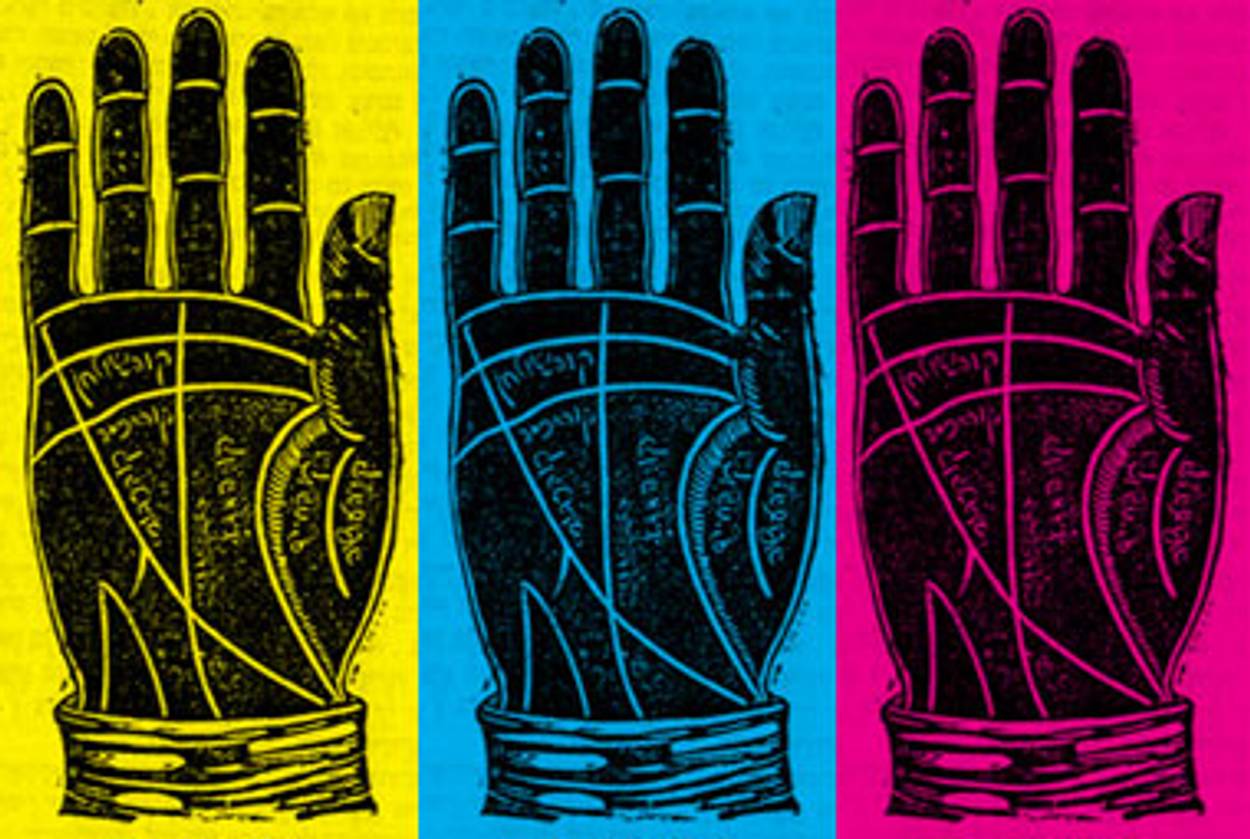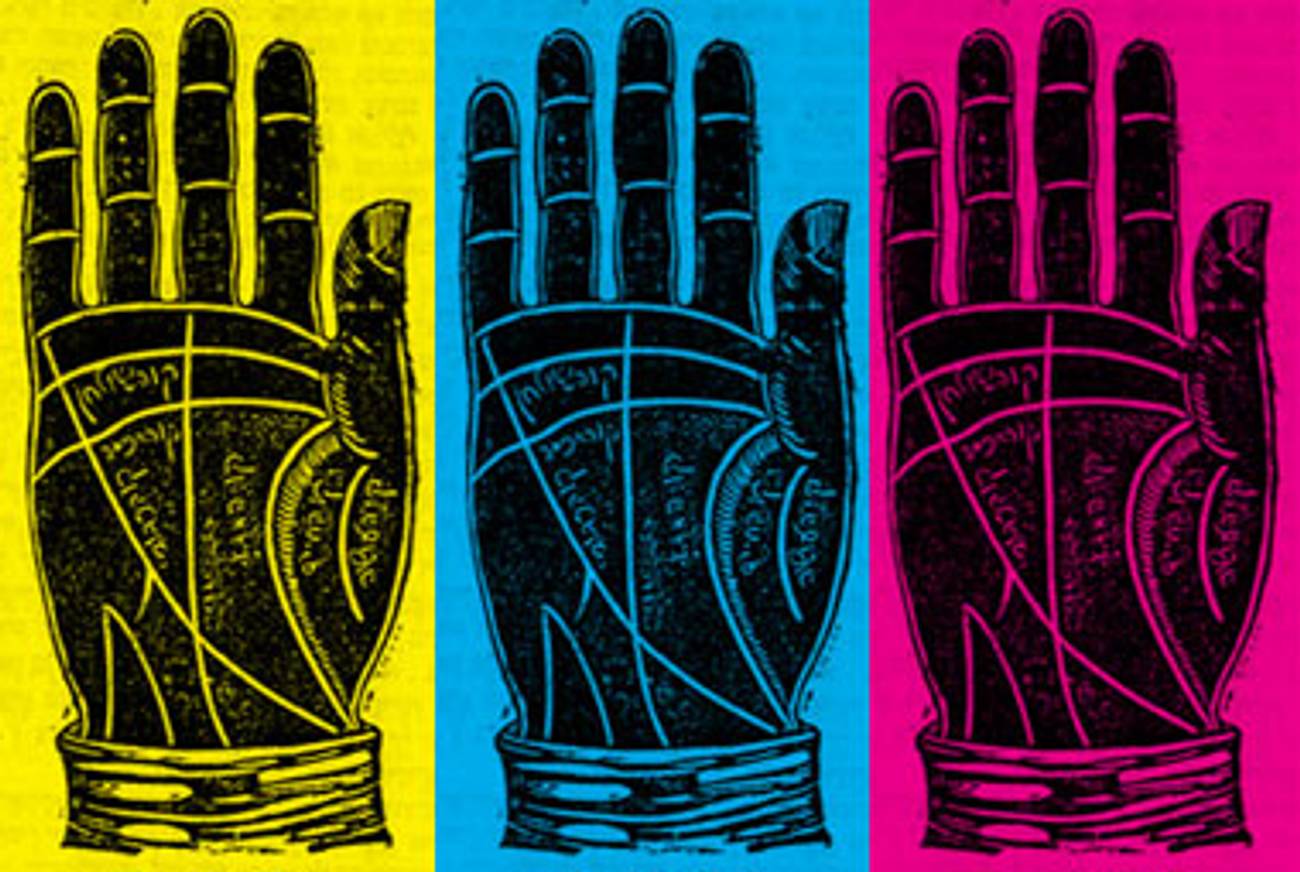In the Palm of His Hand
A look at Abraham Hochman, 19th-century Lower East Side clairvoyant




If you’re a historian, or even if you just play one on TV, you’re keenly aware that one of the convenient aspects of Jewish history is a 3,000-year-old paper trail—material that has allowed Jewish historians to poke and probe the texts of the rabbinical and intellectual elite that crafted the contours of Jewish law and history. In contrast, we tend to know less about the lives of average Jews, whose lives didn’t receive much attention in the writings of the intellectuals. This began to change in the late 19th century when the Yiddish press hits the streets. It was there that the lives of unwashed Jews were unfurled for the public record. And it is here, in this monthly column, that some of those histories will reappear, for the edification of common reader and intellectual alike.
* * *
One of the items that historians have done a neat job of obscuring as irrelevant to the modern Jewish experience is the role of performance psychics in Jewish life. Legitimized as “prophets” in the ancient period, they have become, in subsequent eras, excused as products of their times or categorized as special “mystics.” But even by the time the Renaissance was in full swing, science and mysticism still mixed in weird and uncomfortable ways: mathematician and physicist Isaac Newton, for example, was a big fan of alchemy and divination, among other matters of the occult. (Apparently, rationality has never been beholden to the laws of motion and gravity.) In the modern period, where science and reason begin to edge out the occult, the terms “fraud” and “charlatan” are bandied about as terms to describe those who work as palm readers, phrenologists, and telepaths. But that didn’t make them disappear or make people any less interested in their abilities, including some with top flight educations.
Indeed, Jews have worked in the occult for as long as they have been Jews. Instances of necromancy and other occult activities are peppered throughout the Bible and the Talmud, as well as later rabbinical texts. Indeed, prophesying is hardwired in the tradition. Joshua Trachtenberg’s 1939 monograph, “Jewish Magic and Superstition,” for example, regales the reader with an excellent exposition of the history of Jewish occult activity.
With the advent of the Enlightenment and political and social emancipation it brought in its wake, Jews were expected to have abrogated this silliness. But shtetl superstitions simply migrated in variant form to cities, where—in an attempt to slap a veneer of sophistication on their ancient crafts—occultists often presented themselves as “scientists” or “professors.” They could be found in Jewish neighborhoods in Warsaw, Krakow, and New York City plying their trades.
One such specimen, a man named Abraham Hochman, came to prominence in mid-1890s New York, following the 1895 publication of Fortune Teller, a popular booklet reprinted several times—as were his subsequent Yiddish publications on astrology and fortune telling. Operating out of a building he owned at 169 Rivington Street, Hochman was a Lower East Side fixture who told fortunes, read palms and foreheads, and found lost spouses and kin for people in the neighborhood. He kept innocent men out of prison, found lost property and, occasionally, knew which horse would come in at the track. When business flagged, he contacted journalist friends and pulled stunts, most of which were reported upon assiduously in the Yiddish press, to attract customers.
Occasionally, when Hochman did something really dramatic, news of his exploits would appear in the general press. The New York Sun, among other outlets, reported on an episode in May 1904, when a bushy-haired Hochman waltzed into the Essex Market Police Court and inexplicably paid the bail for Abie Langener, who’d been arrested with seven other youths on a burglary charge. The magistrate asked why Hochman was paying bail for someone he didn’t know.
“I can read the future,” he replied. “I have read this man’s mind and know he is innocent. I can also read your mind. You will discharge him when the case comes up before you tomorrow. If he were guilty, I would know it and I would not bail him out. I will be here tomorrow to show you that my predictions come true.”
Hochman did, in fact, show up the following day. And, sure enough, when Langener and another suspect were brought before the court, the magistrate released them due to lack of evidence.
“What did I tell you?” said Hochman.
The psychic was mobbed outside the courthouse by hundreds of friends of the accused who, according to press reports, practically tore off his clothes. It’s not clear why this would be necessary and, in any case, the courthouse bailiffs came outside to rescue him from his demonstrative well-wishers.
But Hochman was usually surrounded by a mob, though typically of what they called “wildly gesticulating women.” The stoop of his Rivington Street studio was frequently crammed with flailing ladies, often accompanied by children all desperately trying to find missing husbands and fathers. These men ranged from immigrants who had conveniently “forgotten” about their families in the Old Country, to guys who couldn’t tolerate the cramped quarters of their 300-square-foot tenements and their half dozen screaming kids, to jerks who ran out of money and disappeared. The situation was so bad, the Jewish Daily Forward, the largest-circulation Yiddish daily in the world, began running the “Gallery of Missing Men,” a page full of mug shots and descriptions of these nefarious characters to help locate them and bring them to justice. (The National Desertion Bureau was also founded to help women and children whose husbands and fathers were on the lam.)
Locating missing husbands was a Hochman specialty. He gained quite a bit of fame for this ability when, in 1903, the press reported on the predicament of Minnie Cohen, whose her husband went missing for a month. Minnie decided to avail herself of Hochman’s services. With a dollar in hand, she made her way through the labyrinthine snarl of panhandlers and pushcarts to Hochman’s office. He informed Minnie that her husband would be up to no good at the corner of Pitt and Grand Streets at exactly 10 o’clock that night. So sure was he of his prophecy that he promised to give her 50 dollars if he turned out to mistaken. With unshakable faith in the Hebrew Seer of Rivington Street, and hope in the possibility of getting a wad of cash if her runaway husband didn’t show, Cohen pulled a cop out of the Essex Street Station and told him what Hochman had said. When they got to the corner of Pitt and Grand, Minnie’s truant husband was there, scratching his back on a lamppost. Officer O’Grady arrested Cohen’s husband and brought him into the station, where he was held on a $100 bond and instructed to begin paying his wife Minnie two dollars a week alimony. “Venus is ascendant—husbands beware!” Hochman asserted to the women gathered on his stoop.
News of his exploits made Hochman realize that he could expand his psychic constituency further than the local Hebrews. He went straight for the top: one day in the spring of 1905, Hochman went chugging into the Grand Street clubhouse of Tammany Hall thug Florrie Sullivan, grabbed the local strongman’s hand, and told him that he dreamed that the horse King Pepper was going to come in first, paying eight to one. Sullivan, who forswore belief in the occult, nevertheless took a bet on Hochman’s advice. King Pepper won, making Sullivan a small fortune. Hochman’s gambit worked; he became the Sullivan gang’s official mind-reader and phrenologist. Hochman was so successful that his son Frank’s 1906 bris, which brought out a full police battalion and included performances by Yiddish theater actors, was besieged by thousands of well wishers, who devoured 320 pounds of chicken and six crates of fruit. On account of this sumptuous affair, an entire block of Rivington Street was closed down for two days.
Even The New York Times was not immune to the lures of Abraham Hochman. Tongue in cheek as it may have been, the Times still reported on the 1904 story of how Hochman’s psychic abilities helped to locate Jacob Greenberg’s (of the Essex Street Greenbergs) missing horse, cart, and load of grapes.
Unlike most clairvoyants, Hochman was happy to share his secrets, publishing his prophetic techniques in books and articles. He based his method on what he called his “Astro-biblical chart,” which anyone could use to answer questions like “will I fall in love?”; “should I take dance lessons?”; “does my husband know I’ve been bad?”; “should I get a job as a tailor?”; “is my landlord in love with me?” Determining the answer required readers to hold some herbs or nuts in the right hand, count backwards by sevens with the left hand, add whatever remained to the number of the question, and find the corresponding number on the astro-biblical chart, which provided the name of a Hebrew symbol and a natural element. Then, inquirers were to take the Hebrew symbol and the element and consult Hochman’s system of charts for another number which led to the answer chart, whereupon a person would punch in the original number subtracted after the initial step of nut-holding and backward counting. That is your answer. How could it miss?
Hochman disappears from the papers around 1910. Nobody seems to know what became of him, though Yiddish-speaking clairvoyants, palm readers, and psychics continued to hold Jews in their thrall. In 1933, for example, a dybbuk was exorcised in a Harlem tenement. But that’s a story for another time.
Eddy Portnoy, a Tablet contributing editor, teaches Yiddish language and literature at Rutgers University.
Eddy Portnoy, a contributing editor for Tablet Magazine, is the Academic Advisor and Exhibitions Curator at the YIVO Institute for Jewish Research. He is also the author of Bad Rabbi and Other Strange but True Stories from the Yiddish Press.
Eddy Portnoy is academic adviser and director of exhibitions at the YIVO Institute for Jewish Research, as well as the author of Bad Rabbi and Other Strange but True Stories from the Yiddish Press (Stanford University Press 2017).